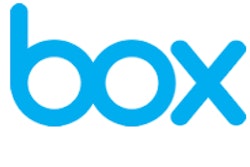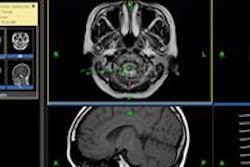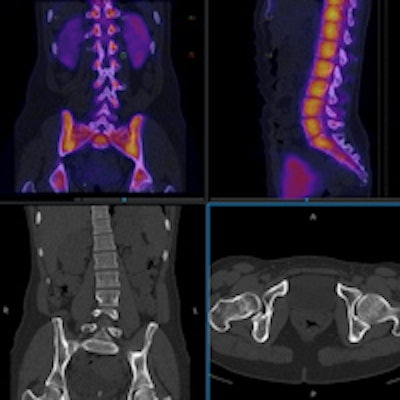
Despite near ubiquitous adoption of electronic health records (EHRs) in the U.S., many workflow tasks still rely on paper and faxes. Cloud storage vendor Box hopes to change that with the launch of Box for Healthcare at this week's Healthcare Information and Management Systems Society (HIMSS) meeting in Las Vegas.
Box for Healthcare is the first Box package specifically tailored to hospitals. It is designed to help streamline referral management, assist with data transfer and capture, and address many of the interoperability issues that hospitals face today, said Missy Krasner, Box's managing director of healthcare and life sciences.
"What we've learned over time with hospitals is that even though they're moving data to the cloud and are really trying to collaborate internally with departments as well as with referring physicians, patients, and/or payors, if they're in a shared risk kind of an arrangement, they are still heavily reliant on a lot of manual workflow," Krasner said. "So we're still seeing a lot of faxing, and we're still seeing a lot of scanning. This is even when you have a 90% adoption level across the nation for certified electronic health record use."
Around 61% of the workflow associated with referrals coming in and out of the hospital is still fax-based, which represents a major opportunity for cloud vendors such as Box to help institutions modernize and digitize their workflows, Krasner said.
Box DICOM Viewer
Box for Healthcare includes Box's current HIPAA-compliant content management platform, which has been available for healthcare customers for the past three years. Thanks to its acquisition of cloud-based RIS/PACS developer MedXT in October 2014, Box is also now debuting the Box DICOM Viewer, an HTML5-based application that supports viewing of medical images on a Web browser and/or mobile phone. The Box DICOM Viewer has received U.S. Food and Drug Administration (FDA) 510(k) clearance as a class II medical device for diagnostic viewing applications.
"It can talk to a hospital-based PACS so that we can autonominate and upload all images from a PACS into a Box folder, and then those can be viewed, shared, stored, annotated, and measured, or key images can be saved," she said. "Many hospitals have already invested in their equipment as well as their PACS and even [vendor-neutral archives]. Box [for Healthcare] is going to be additive, in that it can unlock some of these enterprise-based software solutions that help facilitate the movement of files at the hospital on-premises ... but don't really help with exchanging images outside of the firewall of the hospital."
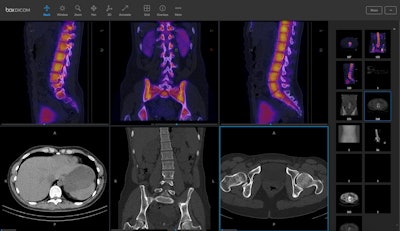
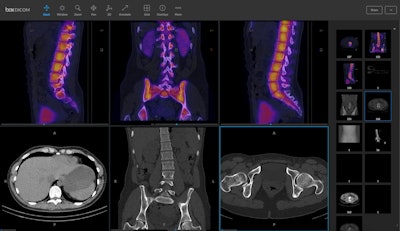
The Box DICOM Viewer has received FDA clearance for diagnostic use. Image courtesy of Box.
The Box software could be used in a variety of applications, such as for sharing patient images -- instead of on CDs -- or for wet-read consults by physicians on their phone, Krasner said.
Box for Healthcare also includes Box Governance, a service that helps customers comply with regulatory policies on data retention. In addition, it offers features that allow users to control who can share information with their institution, said Brandon Savage, director of product management for industries at Box.
"It can help expand the perimeter of your organization, but really protect the boundaries of what you're willing to share and what you're willing to bring in," Savage said.
Integration with faxing software
Also at HIMSS 2016, Box is highlighting its integration capabilities with HIPAA-compliant faxing software, obviating the need for manual management of incoming faxes for referrals.
"We can actually take that [faxing] workflow and directly map it into a Box folder, so you can start reviewing these cases all online; you don't have to scan them and you don't have to actually walk them around the corner," Krasner said. "You can assign tasks, comment, and do the entire referral review and scheduling all in Box using our collaborative features."
Box for Healthcare also supports the Direct Messaging protocol for transfer of patient data from Box to an electronic health record or vice versa.
"If your EHR is Direct-enabled -- and pretty much every single certified EHR is -- we can map a direct URL address into a Box folder and use the Direct send and receive protocol to securely send patient data from the EHR into Box and/or from Box to the EHR," Krasner said. "This would work with [personal health records] as well, or any kind of enterprise solution that maintains clinically structured data."
A special viewing application parses the data into a viewable format within Box, allowing users to view, share, or store the information, Krasner said. Box also offers a consulting package to assist with implementation and adopting best practices.
The Box DICOM Viewer is now commercially available, and the other elements of Box for Healthcare will be rolled out initially in limited release, Krasner said.
In related developments at HIMSS 2016, Box has expanded its partnership with HIPAA-compliant texting application provider TigerText. Via the TigerText mobile interface, users of TigerText will now be able to view medical images stored in Box via the Box DICOM Viewer, according to the firm.





